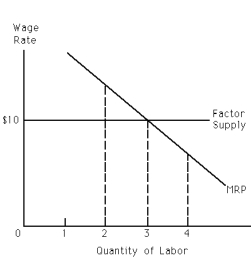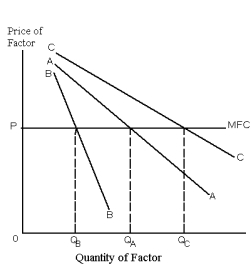A) a decrease in the demand for Y
B) a rise in the MPP of factor X
C) a fall in the price of good Y
D) a fall in the cost of employing factor X
E) a and b
Correct Answer

verified
B
Correct Answer
verified
Multiple Choice
Exhibit 27-4
 -Refer to Exhibit 27-4.The marginal factor cost of labor
-Refer to Exhibit 27-4.The marginal factor cost of labor
A) is $14.
B) is $7.
C) is $3.
D) is $10.
E) depends on the amount of labor employed.
Correct Answer

verified
Correct Answer
verified
Multiple Choice
Exhibit 27-6
 -Refer to Exhibit 27-6.Let AA and MFC represent the value of marginal product curve and the marginal factor cost curve of a monopolist,respectively.Which of the following is a possible profit-maximizing factor quantity the monopolist will employ?
-Refer to Exhibit 27-6.Let AA and MFC represent the value of marginal product curve and the marginal factor cost curve of a monopolist,respectively.Which of the following is a possible profit-maximizing factor quantity the monopolist will employ?
A) QA
B) QB
C) QC
D) none of the above is possible
Correct Answer

verified
Correct Answer
verified
Multiple Choice
For a perfectly competitive firm,when the price of the product it sells rises,its MRP of labor curve __________,while its VMP of labor curve __________.
A) stays where it is; shifts to the right
B) shifts to the right; shifts to the right
C) shifts to the right; stays where it is
D) shifts to the left; shifts to the left
Correct Answer

verified
Correct Answer
verified
Multiple Choice
Given a 3 percent decrease in wages,firm A hires more labor than firm B.It follows that,ceteris paribus,
A) the elasticity of demand for the product that firm A produces is lower than the elasticity of demand for the product that firm B produces.
B) firm A has a lower labor cost-total cost ratio than firm B.
C) firm A has more substitutes for labor than firm B.
D) firm A has higher per-unit costs than firm B.
E) none of the above
Correct Answer

verified
Correct Answer
verified
True/False
Marginal productivity theory states that if a firm sells its product in a perfectly competitive product market it will necessarily pay its factors their VMP.
Correct Answer

verified
Correct Answer
verified
Multiple Choice
A factor price taker is a firm that
A) can sell as many units of its good as it wants without affecting price.
B) sells fewer units of its good at higher prices than lower prices.
C) can buy all of a factor it wants at the equilibrium price.
D) drives up factor price if it buys an additional factor unit.
E) none of the above
Correct Answer

verified
C
Correct Answer
verified
True/False
Labor supply is a reflection of the number of persons who can actually do a job.
Correct Answer

verified
Correct Answer
verified
Multiple Choice
A decrease in the wage rate
A) shifts the supply curve of labor rightward.
B) increases the quantity supplied of labor.
C) shifts the supply curve of labor leftward.
D) decreases the quantity supplied of labor.
Correct Answer

verified
Correct Answer
verified
Multiple Choice
Firm X is a monopolistic competitive firm and a factor price taker.For this firm at the profit-maximizing factor quantity,
A) VMP = MRP > MFC = factor price.
B) VMP> MRP = MFC > factor price.
C) VMP > MRP = MFC = factor price.
D) VMP < MRP = MFC = factor price.
Correct Answer

verified
Correct Answer
verified
True/False
Employers use screening mechanisms,such as GPA,because they lack complete information about job applicants.
Correct Answer

verified
Correct Answer
verified
Multiple Choice
Marginal productivity theory implies that a worker will be paid a wage (W) such that
A) W = MRP, but W < VMP.
B) W < MRP, but W = VMP.
C) W = MRP and W = VMP.
D) W = MFC, but W < MRP.
E) W < MRP and W < VMP.
Correct Answer

verified
C
Correct Answer
verified
Multiple Choice
Consider two labor markets,A and B.Wages in labor market A rise.This could be due to
A) decreasing wages in labor market B.
B) the negative nonpecuniary aspects of work in labor market A rise.
C) the number of people who can do the work that is done in labor market A increases.
D) the demand for the product that employees in labor market A produce falls.
E) a and d
Correct Answer

verified
Correct Answer
verified
Multiple Choice
If a perfectly competitive firm is a factor price taker,at the profit- maximizing factor quantity
A) VMP = MRP.
B) MRP = MFC.
C) MFC = factor price.
D) both a and b
E) all of the above
Correct Answer

verified
Correct Answer
verified
Multiple Choice
The market demand curve for labor is
A) the horizontal summation of the firms' demand curves for labor, derived exactly the same way the product market demand curve is derived from the consumers' demand curves.
B) the vertical summation of the firms' demand curves for labor.
C) any one firm's demand curve labor multiplied horizontally by the number of firms in the labor market.
D) none of the above
Correct Answer

verified
Correct Answer
verified
Multiple Choice
The value of marginal product (VMP) is
A) equal to the product price multiplied by the marginal physical product of the factor.
B) equal to marginal revenue product for a product price taker.
C) the firm's factor demand curve if the firm is a product price taker.
D) a measure of the value that each factor unit adds to the firm's product.
E) all of the above
Correct Answer

verified
Correct Answer
verified
Multiple Choice
Situation 27-2
 -Refer to Situation 27-2.The output produced per $1 of cost in the U.S.is
-Refer to Situation 27-2.The output produced per $1 of cost in the U.S.is
A) 120 units of good Y.
B) 0.83 units of good Y.
C) 22 units of good Y.
D) 2 units of good Y.
Correct Answer

verified
Correct Answer
verified
Multiple Choice
Exhibit 27-l
 -Refer to Exhibit 27-1.What dollar value goes in blank (C) ?
-Refer to Exhibit 27-1.What dollar value goes in blank (C) ?
A) $300
B) $12
C) $30
D) $84
Correct Answer

verified
Correct Answer
verified
Multiple Choice
The factor demand curve shifts leftward as a result of
A) an increase in the price of the product the factor helps to produce.
B) an increase in the marginal physical product of the factor.
C) a decrease in the price of the product the factor helps to produce.
D) a and b
E) b and c
Correct Answer

verified
Correct Answer
verified
Multiple Choice
A perfectly competitive firm will continue to hire more factor units as long as
A) MRP > MFC.
B) VMP > MFC.
C) MRP > VMP.
D) VMP = MFC.
E) a and b
Correct Answer

verified
Correct Answer
verified
Showing 1 - 20 of 181
Related Exams